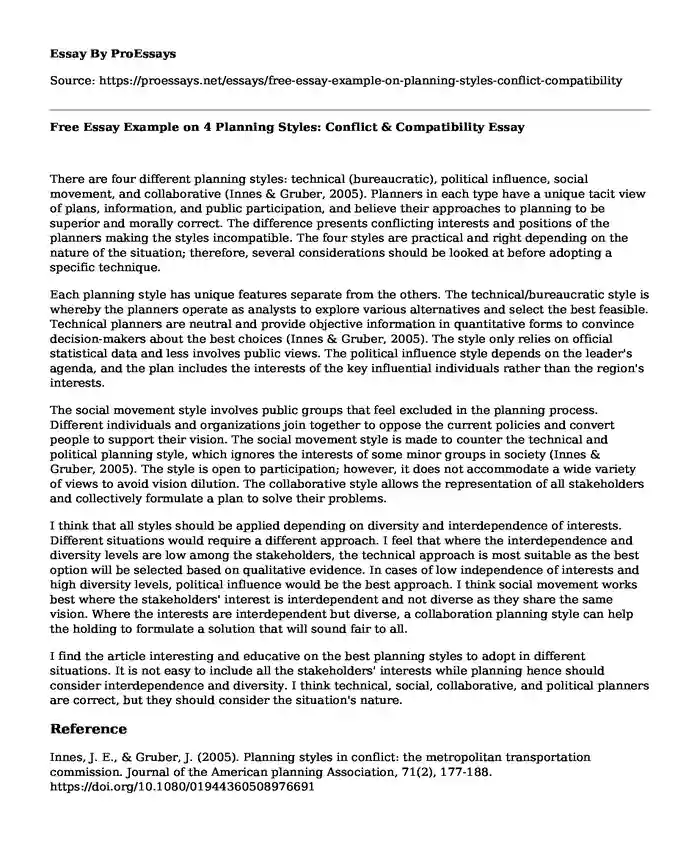There are four different planning styles: technical (bureaucratic), political influence, social movement, and collaborative (Innes & Gruber, 2005). Planners in each type have a unique tacit view of plans, information, and public participation, and believe their approaches to planning to be superior and morally correct. The difference presents conflicting interests and positions of the planners making the styles incompatible. The four styles are practical and right depending on the nature of the situation; therefore, several considerations should be looked at before adopting a specific technique.
Each planning style has unique features separate from the others. The technical/bureaucratic style is whereby the planners operate as analysts to explore various alternatives and select the best feasible. Technical planners are neutral and provide objective information in quantitative forms to convince decision-makers about the best choices (Innes & Gruber, 2005). The style only relies on official statistical data and less involves public views. The political influence style depends on the leader's agenda, and the plan includes the interests of the key influential individuals rather than the region's interests.
The social movement style involves public groups that feel excluded in the planning process. Different individuals and organizations join together to oppose the current policies and convert people to support their vision. The social movement style is made to counter the technical and political planning style, which ignores the interests of some minor groups in society (Innes & Gruber, 2005). The style is open to participation; however, it does not accommodate a wide variety of views to avoid vision dilution. The collaborative style allows the representation of all stakeholders and collectively formulate a plan to solve their problems.
I think that all styles should be applied depending on diversity and interdependence of interests. Different situations would require a different approach. I feel that where the interdependence and diversity levels are low among the stakeholders, the technical approach is most suitable as the best option will be selected based on qualitative evidence. In cases of low independence of interests and high diversity levels, political influence would be the best approach. I think social movement works best where the stakeholders' interest is interdependent and not diverse as they share the same vision. Where the interests are interdependent but diverse, a collaboration planning style can help the holding to formulate a solution that will sound fair to all.
I find the article interesting and educative on the best planning styles to adopt in different situations. It is not easy to include all the stakeholders' interests while planning hence should consider interdependence and diversity. I think technical, social, collaborative, and political planners are correct, but they should consider the situation's nature.
Reference
Innes, J. E., & Gruber, J. (2005). Planning styles in conflict: the metropolitan transportation commission. Journal of the American planning Association, 71(2), 177-188. https://doi.org/10.1080/01944360508976691
Cite this page
Free Essay Example on 4 Planning Styles: Conflict & Compatibility. (2023, Nov 24). Retrieved from https://proessays.net/essays/free-essay-example-on-planning-styles-conflict-compatibility
If you are the original author of this essay and no longer wish to have it published on the ProEssays website, please click below to request its removal:
- Motivational Techniques at Jack Stores Paper Example
- Essay Example on High-Profile Career, Family Sacrifice: The Story of Anne Marie Slaughter
- Essay Example on Promoting Healthy Weights: Parent & School Interventions
- Colonialism's Legacy in Central Africa: Marginalization of Minority Groups - Essay Sample
- Essay Example on Apple's Leadership Edge: How Steve Jobs Transformed Performance
- Parental Socialization: Gender Beliefs and Kids' Behaviours - Essay Sample
- The Power of Coalitions - Free Essay Sample







